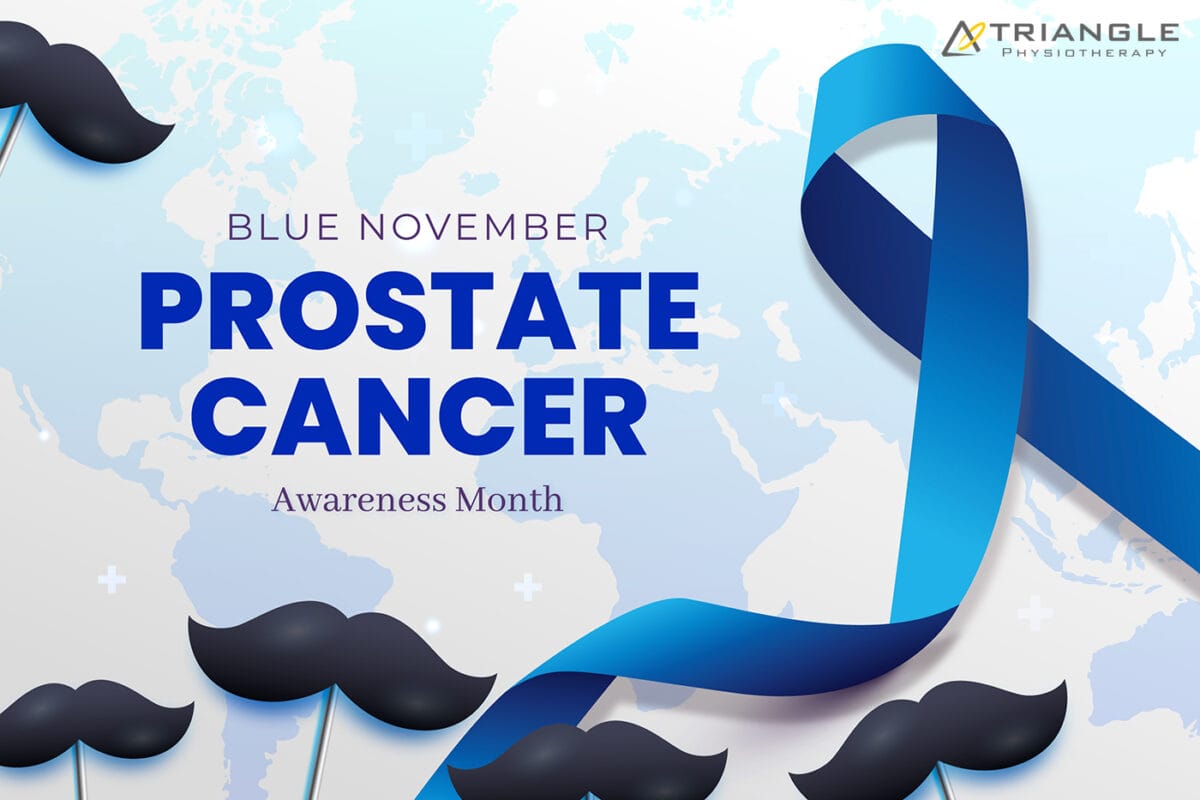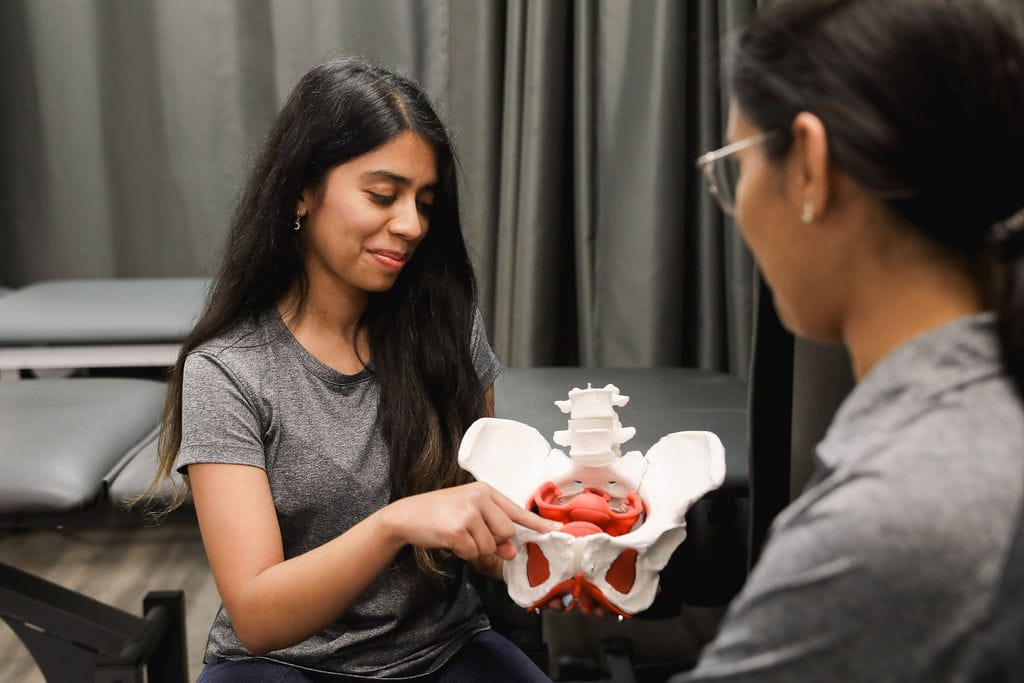Pelvic Physiotherapy, a specialized form of physiotherapy, plays a vital role in helping men regain control, improve function, and enhance their quality of life after prostate cancer treatment.
Prostate cancer is one of the most common cancers affecting men worldwide. While advances in medical treatments like surgery, radiation, and chemotherapy have improved survival rates, the recovery process can often come with a range of physical challenges. One area that is often overlooked is the pelvic health of men post-prostate cancer treatment.
Get in touch with us at Triangle Physiotherapy, we have physiotherapists that are trained in cancer rehabilitation as well as pelvic health. We can help you recover from the side effects of cancer treatment and regain your quality of life.
Prostate Cancer and Its Impact

Prostate cancer typically develops in the prostate gland, a small organ located below the bladder. Treatment options can include surgery (prostatectomy), radiation therapy, hormone therapy, or chemotherapy. While these treatments are effective in managing cancer, they often lead to side effects, particularly in the pelvic region. Common issues that arise after prostate cancer treatment include urinary incontinence, erectile dysfunction, pelvic pain, and difficulty with bowel control.
These conditions can significantly affect a man’s physical and emotional well-being, leading to decreased quality of life, social withdrawal, and even depression. This is where pelvic rehabilitation comes in.
What Is Pelvic Rehabilitation?
Pelvic rehabilitation is a specialized form of physical therapy that focuses on restoring function to the pelvic floor muscles and addressing issues related to the pelvic organs. These muscles support the bladder, bowel, and reproductive organs. For men recovering from prostate cancer, pelvic rehabilitation can help restore strength, control, and coordination in the pelvic region, leading to improvements in urinary control, sexual function, and overall pelvic health.
A trained pelvic health physiotherapist will assess the patient’s specific symptoms and develop a personalized treatment plan. The goal is to reduce discomfort, improve mobility, and enhance the patient’s ability to resume normal daily activities.
How Pelvic Health Physiotherapy Helps After Prostate Cancer Treatment
1. Improving Urinary Control
Urinary incontinence is a common side effect after prostate cancer surgery or radiation. The pelvic floor muscles, which help control urine flow, can become weakened or damaged during treatment. Pelvic rehabilitation techniques, including exercises to strengthen these muscles, can help men regain bladder control and reduce the frequency of leaks. Kegel exercises and electrical stimulation are often used to retrain the pelvic floor muscles and improve urinary continence.
2. Enhancing Sexual Function
Erectile dysfunction (ED) is another common concern after prostate cancer treatment. Pelvic rehabilitation can help address ED by improving blood flow to the penis and strengthening the pelvic floor muscles that contribute to sexual function. Manual therapy, muscle retraining, and pelvic exercises can also help men regain confidence and improve their sexual health.
3. Relieving Pelvic Pain
Pelvic pain or discomfort can persist after treatment, especially if nerve tissue was affected during surgery or radiation. Manual therapy techniques such as myofascial release, soft tissue mobilization, and gentle stretching can help relieve pain, improve flexibility, and reduce tension in the pelvic area.
4. Improving Bowel Function
For some men, prostate cancer treatment can lead to bowel dysfunction, such as constipation or fecal incontinence. Pelvic rehabilitation techniques can help restore normal bowel function by strengthening the muscles involved in bowel control and improving coordination between the pelvic floor and the digestive system.
The Importance of Early Intervention
The sooner men begin pelvic rehabilitation after prostate cancer treatment, the better the outcomes. Early intervention can help prevent long-term complications, reduce recovery time, and improve overall quality of life. It’s important to consult a pelvic health physiotherapist who specializes in post-cancer recovery for a personalized treatment plan.
Call us today to book an appointment and learn about how we can help you.
Pelvic pain is discomfort or pain experienced in the lower part of the abdomen, below the belly button and between the hips. This type of pain can affect both men and women and can arise from various conditions. The nature of pelvic pain can vary; it might be sharp, dull, intermittent, or constant, and can be acute (short-term) or chronic (lasting longer than six months).
What causes pelvic pain?

Common Causes of Pelvic Pain
In Women:
- Menstrual Cramps: Pain associated with menstruation (dysmenorrhea).
- Endometriosis: A condition where tissue similar to the lining inside the uterus grows outside of it.
- Ovarian Cysts: Fluid-filled sacs on the ovaries.
- Pelvic Inflammatory Disease (PID): An infection of the reproductive organs.
- Fibroids: Noncancerous growths in the uterus.
- Ectopic Pregnancy: A pregnancy occurring outside the uterus.
- Interstitial Cystitis: Chronic inflammation of the bladder.
In Men:
- Prostatitis: Inflammation of the prostate gland.
- Hernia: When an organ pushes through an opening in the muscle or tissue.
- Chronic Pelvic Pain Syndrome (CPPS): Persistent pain in the pelvic region.
Both Genders:
- Urinary Tract Infections (UTIs): Infections in any part of the urinary system.
- Appendicitis: Inflammation of the appendix.
- Gastrointestinal Issues: Conditions such as irritable bowel syndrome (IBS) or diverticulitis.
- Musculoskeletal Issues: Problems with muscles, ligaments, or joints in the pelvic area.
What are the symptoms related to pelvic pain?
Symptoms of pelvic pain can vary widely depending on the underlying cause and the individual. Here are common symptoms associated with pelvic pain:
General Symptoms of Pelvic Pain
- Aching or Discomfort: Persistent or intermittent pain in the lower abdomen or pelvis.
- Sharp or Stabbing Pain: Sudden, severe pain that can come and go.
- Cramping: Muscle cramps or spasms in the pelvic region.
- Pressure: A feeling of heaviness or pressure in the pelvis.
- Burning or Stinging Sensation: Particularly during urination or bowel movements.
- Pain During Physical Activity: Pain that worsens with movement, exercise, or sexual intercourse.
Additional Symptoms in Women
- Menstrual Irregularities: Pain associated with periods (dysmenorrhea), heavy bleeding, or spotting between periods.
- Pain During Ovulation: Mid-cycle pain known as mittelschmerz.
- Pain During Sexual Intercourse: Discomfort or pain during or after sex (dyspareunia).
- Vaginal Discharge: Unusual discharge that might indicate infection.
- Pain with Urination: Particularly if associated with urinary tract infections or interstitial cystitis.
Additional Symptoms in Men
- Pain in the Testicles or Scrotum: Discomfort that can radiate to the pelvic region.
- Urinary Symptoms: Difficulty urinating, frequent urination, or pain during urination.
- Pain with Ejaculation: Discomfort during or after ejaculation.
Symptoms Related to Specific Conditions
- Endometriosis: Severe menstrual cramps, pain during intercourse, and infertility.
- Pelvic Inflammatory Disease (PID): Fever, unusual vaginal discharge, and pain during sex.
- Ovarian Cysts: Sudden, severe pain if a cyst ruptures or causes twisting of the ovary (torsion).
- Ectopic Pregnancy: Sharp, stabbing pain, vaginal bleeding, dizziness, or fainting.
- Interstitial Cystitis: Chronic pelvic pain, urinary urgency and frequency, and pain during intercourse.
- Prostatitis: Pain in the pelvis, genitals, or lower back; difficulty urinating; flu-like symptoms.
- Appendicitis: Sudden, sharp pain that starts near the belly button and moves to the lower right abdomen, accompanied by fever, nausea, and vomiting.
- Hernia: A noticeable bulge in the groin or abdomen, pain that worsens with lifting or bending.
How is pelvic pain diagnosed?
Diagnosing the cause of pelvic pain typically involves:
- Medical History and Physical Examination: Initial evaluation by a healthcare provider.
- Imaging Tests: Ultrasound, CT scans, or MRI to visualize internal structures.
- Laboratory Tests: Blood tests, urine tests, or cultures to check for infections.
- Laparoscopy: A minimally invasive surgical procedure to look inside the pelvic cavity.
How is pelvic pain treated?
Treatment depends on the underlying cause and may include:
- Medications: Pain relievers, antibiotics (for infections), or hormonal treatments.
- Physiotherapy: A pelvic health physiotherapist can help with pelvic pain and related symptoms.
- Surgery: In some cases, surgical intervention may be necessary.
- Lifestyle Changes: Dietary adjustments, stress management, and other modifications.
If you or someone you know is experiencing persistent or severe pelvic pain, it’s important to seek medical attention to determine the underlying cause and appropriate treatment.
Where can I find a pelvic health physiotherapist in Mississauga?
We have 8 locations with pelvic health physiotherapists to help you.
- Pelvic Health Physiotherapy Etobicoke – Triangle Physiotherapy Etobicoke
- Oakville Pelvic Health – Triangle Physiotherapy Oakville
- Pelvic Health Physiotherapy North York – Triangle Physiotherapy North York
- Mississauga Pelvic Health – Triangle Physiotherapy Mississauga
- Downtown Pelvic Health – Triangle Physiotherapy King West
- Uptown Toronto Pelvic Health – Triangle Physiotherapy Lawrence Park
- Pelvic Physiotherapy Downtown Toronto – Triangle Physiotherapy Queens Quay
- Mississauga Pelvic Health – Triangle Physiotherapy Erin Mills
Pelvic pain can significantly impact daily life, but targeted physiotherapy can help alleviate discomfort and improve quality of life. If you are looking for professional physiotherapy services to manage pelvic pain, there are clinics in physiotherapy Etobicoke, Oakville, North York, Toronto, Lawrence Park, Queens Quay, Erin Mills, Mississauga, and Liberty Village. These locations offer specialized care and personalized treatment plans to support your pelvic health and overall well-being.
It’s great when sex feels natural and pleasurable, but what happens when that stops happening? Let’s dive into a topic that affects many men but is often shrouded in silence: erectile dysfunction (ED). It’s a sensitive subject, but an important one to address. Did you know that your pelvic floor muscles play a significant role in erectile function? In this blog, we’ll explore how the pelvic floor impacts ED and what can be done to restore function and sexual confidence.
What is the pelvic floor?
Picture the pelvic floor as a team of strong muscles located in your pelvic area. These muscles form the base of the pelvis and support your bladder, rectum, and prostate. These muscles can also face challenges in strength, endurance, or overall quality of muscle tone. This can happen for several reasons, but once it occurs the pelvic floor gets used to these patterns. This can be overwhelming and frustrating.
How does the pelvic floor relate to erectile dysfunction?

Well, the pelvic floor muscles are responsible for a range of functions, including blood flow regulation, maintaining erections, and controlling ejaculation. When these muscles become weak or tense, it can lead to difficulties in achieving or sustaining an erection. Imagine as though there is cement in your muscles, it makes them look strong but they’re not actually functional. These tight muscles can prevent arousal and effective orgasms. It takes more than just strengthening to improve the quality of contraction in these muscles. It is important for a strong muscle to be able to relax, as well as contract for optimal function. Pelvic physiotherapy treatment is focused on restoring that function.
How is the pelvic floor strengthened?
The good news is that you have the power to strengthen your pelvic floor muscles and potentially improve erectile function. A start to strengthening can be kegel exercises, however these are not the answer for everyone. Kegels are similar to a bicep contraction, and the strength plateaus if strengthening only involves kegels. True strength will take more than just 100 kegels. It takes functional training and pelvic floor strengthening in different ranges. It also involves strengthening the other muscles in the inner unit such as the deep core, diaphragm, and multifidi.
Relaxation Techniques:
Sometimes, it’s not just about strength but also about letting go of tension. Stress and anxiety can have a significant impact on your sexual performance. Learning relaxation techniques, such as deep breathing exercises and mindfulness, can help release the tension in your pelvic floor muscles and create a more relaxed and conducive environment for sexual experiences. Another powerful tool is learning how to effectively reverse kegel and strengthen the pelvic floor in the lengthened range.
While self-help exercises are a great start, seeking professional guidance from a pelvic floor physiotherapist can take your journey to the next level. These knowledgeable experts can assess your specific situation, provide tailored exercises, and guide you through techniques that target your pelvic floor muscles. They understand the challenges you may face and approach the topic with empathy and professionalism, creating a safe space for discussion.
Where can I find a pelvic health physiotherapist in Mississauga?
We have 8 locations with pelvic health physiotherapists to help you.
- Pelvic Health Physiotherapy Etobicoke – Triangle Physiotherapy Etobicoke
- Oakville Pelvic Health – Triangle Physiotherapy Oakville
- Pelvic Health Physiotherapy North York – Triangle Physiotherapy North York
- Mississauga Pelvic Health – Triangle Physiotherapy Mississauga
- Downtown Pelvic Health – Triangle Physiotherapy King West
- Uptown Toronto Pelvic Health – Triangle Physiotherapy Lawrence Park
- Pelvic Physiotherapy Downtown Toronto – Triangle Physiotherapy Queens Quay
- Mississauga Pelvic Health – Triangle Physiotherapy Erin Mills
Improving pelvic floor health can play a significant role in managing erectile dysfunction. If you’re seeking expert guidance, consider physiotherapy in Etobicoke, Oakville, North York, Toronto, Lawrence Park, Queens Quay, Erin Mills, Mississauga, or Liberty Village. Skilled physiotherapists in these areas can provide personalized care to help you improve pelvic floor function and overall well-being.
When we think about pelvic health, we often think of women’s issues, but did you know that men also have a pelvic floor? That’s right! The male pelvic floor is a group of muscles that support the bladder, bowel, and sexual organs.
However, just like any other muscle group, the male pelvic floor can become weakened or tense, leading to a variety of issues. For example, pelvic pain, urinary or fecal incontinence, and erectile dysfunction can all be caused by pelvic floor dysfunction.

What are the Causes of Pelvic Floor Dysfunction in Men?
When we think about pelvic health, we often think of women’s issues, but did you know that men also have a pelvic floor? That’s right! The male pelvic floor is a group of muscles that support the bladder, bowel, and sexual organs.
However, just like any other muscle group, the male pelvic floor can become weakened or tense, leading to a variety of issues. For example, pelvic pain, urinary or fecal incontinence, and erectile dysfunction can all be caused by pelvic floor dysfunction.
The pelvic floor conditions we see in men are:
- Post-Prostatectomy Incontinence
- Post-prostatectomy Erectile dysfunction
- Pelvic Pain – Testicular & Penile pain, Chronic Prostatitis
How is Pelvic Floor Dysfunction diagnosed in Men?
Once you come in for an initial assessment, a qualified pelvic health physiotherapist will begin by taking a detailed medical history and a review of your symptoms, followed by an assessment of your symptoms and pelvis.
Once the cause of your pain or dysfunction has been diagnosed, your pelvic health physiotherapist will discuss the findings with you, as well as explain treatment options and expected outcomes.
What to Expect During Pelvic Floor Physiotherapy for Men?
Your pelvic floor physiotherapist will design an individual treatment plan that would aim to meet your goals, which may include one or more of the following; pelvic floor and pelvic muscle exercises, education, mindfulness and relaxation techniques, and bladder and bowel training.
Where can I find a men’s pelvic health physiotherapist in Mississauga?
We have 8 locations with pelvic health physiotherapists to help you.
- Pelvic Health Physiotherapy Etobicoke – Triangle Physiotherapy Etobicoke
- Oakville Pelvic Health – Triangle Physiotherapy Oakville
- Pelvic Health Physiotherapy North York – Triangle Physiotherapy North York
- Mississauga Pelvic Health – Triangle Physiotherapy Mississauga
- Downtown Pelvic Health – Triangle Physiotherapy King West
- Uptown Toronto Pelvic Health – Triangle Physiotherapy Lawrence Park
- Pelvic Physiotherapy Downtown Toronto – Triangle Physiotherapy Queens Quay
- Mississauga Pelvic Health – Triangle Physiotherapy Erin Mills
Pelvic Floor Physiotherapy refers to a specific and advanced field within physiotherapy that deals with Pelvic Floor Dysfunction. Pelvic Floor Dysfunction can impact people of any age or gender and the term describes several conditions that may affect the urinary, reproductive, digestive, sexual, and/or stability systems in the pelvis.
Pelvic Health Physiotherapists have post-graduate training in pelvic health and can resolve many pelvic floor issues in people of all genders and ages.
What type of conditions can Pelvic Floor Physiotherapy help women with?

Pelvic Health physiotherapists at our clinics can help women with the following:
- Pelvic floor and abdominal weakness
- Bladder and bowel problems
- Pelvic pain (endometriosis, bowel, bladder pain)
- Pelvic organ prolapse (POP)
- Sexual dysfunction, vaginismus, painful intercourse
- Prenatal and postnatal care
- Diastasis Recti
- Labour and delivery prep
Can a pelvic health physiotherapist help men?

Pelvic Health physiotherapists at our clinics can help men with the following:
- Pelvic pain
- Bladder and bowel control problems
- Erectile dysfunction
- Pre and post-prostatectomy
Can your pelvic health physiotherapists help transgender individuals?
Yes, our pelvic health physiotherapists can certainly help transgender individuals.
- Surgical preparation and recovery post-surgery
- Pelvic pain – Endometriosis or PCOS
- Intimacy pain, difficulty with penetration
- Pregnancy and postnatal care for Trans-parents
Pelvic Floor Assessment – what does it entail?
Your first appointment will last about an hour. Your pelvic health physiotherapist will discuss your medical history, do a thorough pelvic health assessment and propose a detailed individualized treatment plan to achieve your pelvic health goals. The assessment may include an internal examination, with your consent, of course, depending on your condition.
Triangle Physiotherapy and our pelvic health team are passionate about supporting our transgender and intersex community.
What should I bring to my appointment? What should I wear?
Make sure you have filled out the Health Questionnaire sent to you by our booking team. Bring any physician or specialist referrals to test results you may have. Please wear comfortable clothing, there are no specific requirements.
How many sessions will I need?
After your assessment, your physiotherapist will prepare a treatment plan for you and be able to indicate how many appointments you may need to achieve your pelvic health goals.
Can I attend my appointment if I have my period?
Your pelvic health physiotherapist can treat you while you have your period, as long as you are comfortable with it.
How do I book an appointment to see a pelvic health physiotherapist at Triangle Physiotherapy?
Triangle Physiotherapy has pelvic health physiotherapists at the following locations:
- Etobicoke Pelvic Health – Triangle Physiotherapy Etobicoke
- Mississauga Pelvic Health – Triangle Physiotherapy Mississauga, Triangle Physiotherapy Erin Mills
- North York Pelvic Health – Triangle Physiotherapy North York
- Toronto Pelvic Health – Triangle Physiotherapy King West, Triangle Physiotherapy Queens Quay, Triangle Physiotherapy Lawrence Park
- Oakville Pelvic Health – Triangle Physiotherapy Oakville
Pelvic floor physiotherapy is essential for managing pelvic health issues such as incontinence, pelvic pain, and postpartum recovery. If you are seeking expert physiotherapy services to improve your pelvic health, there are clinics in physiotherapy Etobicoke, Oakville, North York, Toronto, Lawrence Park, Queens Quay, Erin Mills, Mississauga, and Liberty Village. These locations offer specialized care and personalized treatment plans to help you achieve optimal pelvic health and well-being.





